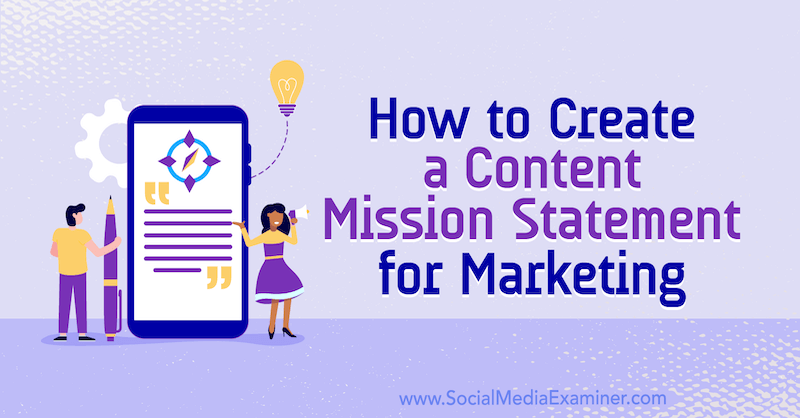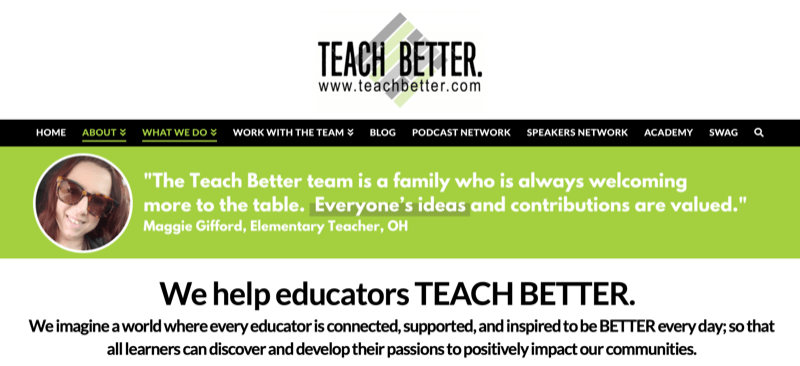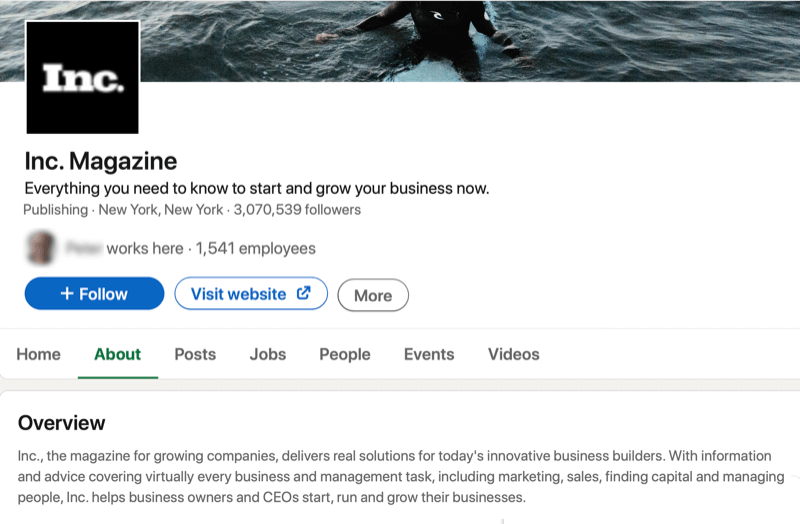Do you use content in your marketing? Could a clear mission statement improve your marketing results?
In this article, you'll learn what a content mission statement is and how to create one to guide your marketing activities.

Why Marketers Need a Content Mission Statement
I started my publishing career over 20 years ago at (then) the largest independent business-to-business (B2B) media company in North America. I was lucky. By working in the custom media group, I had the opportunity to work with most of the company's content brands in dozens of industries. I sat in on executive meetings, eMedia meetings, sales meetings, and most importantly, editorial meetings.
Fast-forward 10 years and I started sitting in on even more editorial meetings, but this time in large product and service brands rather than media companies. These are brands whose names you'd know if I mentioned them here. For the most part, these meetings were led by marketing directors and content marketing managers working on a company blog, podcast, eNewsletter, or YouTube series.
The difference in an editorial meeting at a media company versus a corporate brand was, to say the least, dramatic.
At the beginning of every editorial meeting at a media brand, someone either formally (or informally) discussed the editorial mission statement. While marketers are often busy talking about the marketing goals, editors and journalists are talking about meeting the needs of the audience. Now, there's nothing wrong with content KPIs, leads, and sales, but they have little place in a content or editorial meeting.
That's where a content mission statement comes into play.
A mission statement is a company's reason for existence. It's why the organization does what it does. For example, Patagonia's mission is to build the best products, cause no unnecessary harm, and use business to inspire and implement solutions to the environmental crisis. Tesla's is to accelerate the world's transition to sustainable energy. TED's is to spread ideas.
A content mission statement is the reason for your content's or strategy's existence. It's the marketer's why.
Marketing professionals, with both small and large businesses, get so fixated on channels—blogs, Facebook, TikTok—that many have no clue why they should use a channel in the first place. The why must come before the what. It's critical to first set the tone for building audiences so your marketing can generate revenue from (or because of) those audiences.
So first, you need a content mission statement for your content marketing initiative. And second, once you create the statement, you need to review it with your marketing team during every meeting. A content mission statement is a living, breathing document that needs to be reviewed and updated continually.
Here's how to get started creating your own content mission statement.
#1: Know Who Your Specific Target Audience Is
There are three parts to the content mission statement. Andy Crestodina from Orbit Media calls this the XYZ method: “Our company is where [audience X] finds [content Y] for [benefit Z].”
Get World-Class Marketing Training — All Year Long!
Are you facing doubt, uncertainty, or overwhelm? The Social Media Marketing Society can help.
Each month, you’ll receive training from trusted marketing experts, covering everything from AI to organic social marketing. When you join, you’ll also get immediate access to:
- A library of 100+ marketing trainings
- A community of like-minded marketers
- Monthly online community meetups
- Relevant news and trends updates
Using this method, I'll walk you through one of my favorite content mission statements from Inc. magazine—and one of my own—so you can create a content mission statement for your business.
Simplicity is key. Inc.'s mission statement is incredibly simple and includes no easily misunderstood words:
“Welcome to Inc.com, the place where entrepreneurs and business owners can find useful information, advice, insights, resources and inspiration for running and growing their businesses.”
Nowhere in its mission statement does Inc. talk about how it makes money from its audience. That's where most marketers go wrong with their content creation: They talk about what they want to sell.
The content mission is all about the audience and focusing your team on something bigger than just making money (which is important, but in this case, secondary). You can't make money off of your audience until it actually is your audience.
Now, Inc.'s audience is fairly broad. Depending on your business, product, or service, you may need to niche down to a more granular description of your audience. For example, my new company wants to target content creators, but specifically content creators who are individuals (not at large companies) trying to make a business out of content creation. After some brainstorming, we called this audience group content entrepreneurs.
Another example is TeachBetter.com.

They aren't just targeting teachers, they're targeting dissatisfied teachers who believe there's a better way to teach kids. Remember, it's better to go too niche than too broad.
Now it's your turn—who is your target audience?
#2: Define What Types of Content Your Marketers Will Use to Build Your Audience
Inc.'s content mission statement defined the material it delivers to its audience (entrepreneurs and business owners) as useful information, advice, insights, resources, and inspiration.

Discover Proven Marketing Strategies and Tips
Want to go even deeper with your marketing? Check out the Social Media Marketing Podcast! Publishing weekly since 2012, the Social Media Marketing Podcast helps you navigate the constantly changing marketing jungle, with expert interviews from marketing pros.
But don’t let the name fool you. This show is about a lot more than just social media marketing. With over 600 episodes and millions of downloads each year, this show has been a trusted source for marketers for well over a decade.
While interviewing dozens of content creators for my new book, we found that successful content entrepreneurs focus on one core channel (at first) for a long time. We decided on email as our core offering; email delivered twice per week and focused mostly on revenue-generating and business model strategies.
With these two examples in mind, what types of marketing content will you deliver to build your audience? Be as specific as possible but remember to keep it simple so there's no room for misunderstanding.
#3: Declare How Your Target Audience Will Benefit
Remember, this isn't your benefit—it's your audience's. I've seen too many mission statements with the goal of a certain amount of leads, subscribers, or revenue. Your overall content marketing strategy should include your KPIs and marketing goals, not your content mission statement.
The outcome/benefit for Inc.'s audience (entrepreneurs and business owners) is that Inc.'s content (useful information, advice, insights, resources, and inspiration) will help them run and grow their businesses.

In my own example, we believe our content will enable content creators to build sustainable, profitable long-term businesses.
What's the key outcome for your audience?
Pro Tip: Are your marketers delivering a content product that's consistent? If so, you need a manageable frequency delivered in a familiar manner over a long period.
#4: Create Your Content Mission Statement
Taking these three components together—audience, content, and benefit—my company's content mission statement has become:
“Welcome to The Tilt, a twice-a-week newsletter containing revenue generating tips and business model strategies (what we deliver) for content creators who want to be or already are content entrepreneurs (who we deliver it to) to build a profitable long-term business and become financially independent (the audience benefit).”
Now combine your answers from above to get your new content mission statement.
Is One Content Mission Statement Enough?
Twenty years ago at my job with the B2B media company, I worked with about 40 different magazine/content brands. Care to guess at how many mission statements there were? You guessed it… 40.
If you're targeting a different audience, delivering different kinds of stories, or pursuing different outcomes with your stories, you need a separate mission statement. For example, when I was at Content Marketing Institute, our blog had one mission and our magazine had a totally different content mission. This was because the blog audience was content marketers while the magazine audience was CMOs.
#5: Use Your Content Mission Statement Daily
Many content marketers work with their teams, create a fantastic content mission, and then stick the statement in a drawer or never open the shared document again.
With each new piece of content your marketing team creates, ask these questions:
- Are we focusing on the correct audience?
- Does this content meet the needs of our audience?
- What's the audience outcome we want to achieve with this story?
As you learn more about your audience and the stories you're going to tell, your mission most likely will change. In this case, it's best to read your content mission statement aloud before each content meeting. Make it a ritual or habit.
This is important for four reasons:
- You want to make sure every member of the team is clear on the content goal. Any confusion will cause real problems with your content creation efforts.
- It will keep your content team focused. It's difficult to target the wrong audience or a different outcome after just reviewing it in the meeting.
- Sometimes things change. If you read out the mission statement and come to the realization that your target audience should be more niche or different in some way, it's great to catch this before all of the content creation work is completed.
- It's easy to be seduced by marketing goals. Actively leveraging the content mission statement will keep you focused on building your audience first and driving revenue second.
Conclusion
The greatest media companies and the best content marketing examples in the world have one thing in common: They create and actively use a content (or editorial) mission statement. If you're having problems with your marketing content creation efforts, your content marketing team, or hitting your content marketing goals, the problem may be that you lack a true mission. If so, it's time to get one.
Get More Advice on Social Media Marketing
- Develop a pipeline of content ideas that never ends.
- Promote your content via social media.
- Repurpose video and audio into multiple formats you can share on your social media channels.
Attention Agency Owners, Brand Marketers, and Consultants

Introducing the Marketing Agency Show–our newest podcast designed to explore the struggles of agency marketers.
Join show host and agency owner, Brooke Sellas, as she interviews agency marketers and digs deep into their biggest challenges. Explore topics like navigating rough economic times, leveraging AI, service diversification, client acquisition, and much more.
Just pull up your favorite podcast app, search for Marketing Agency Show and start listening. Or click the button below for more information.

